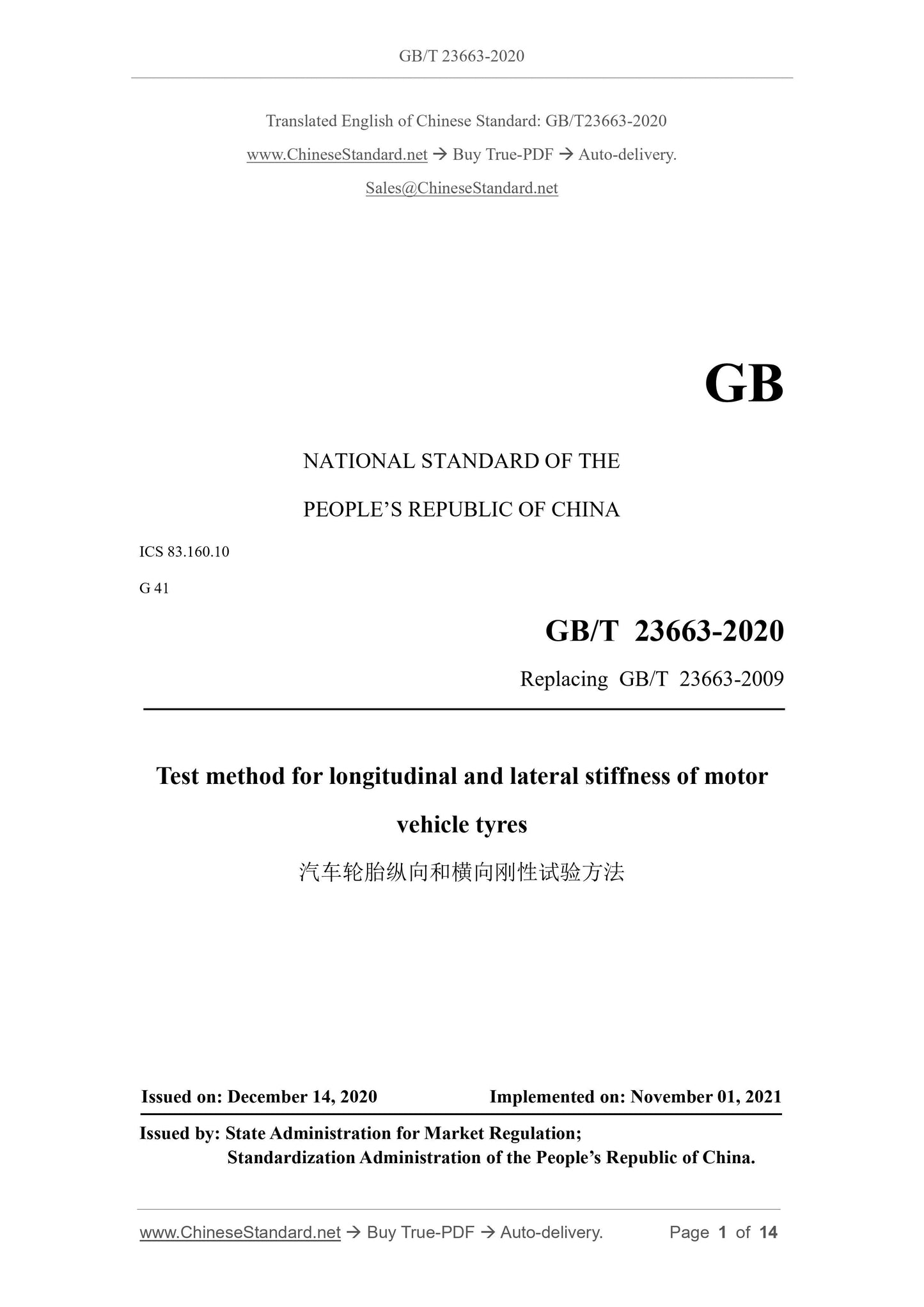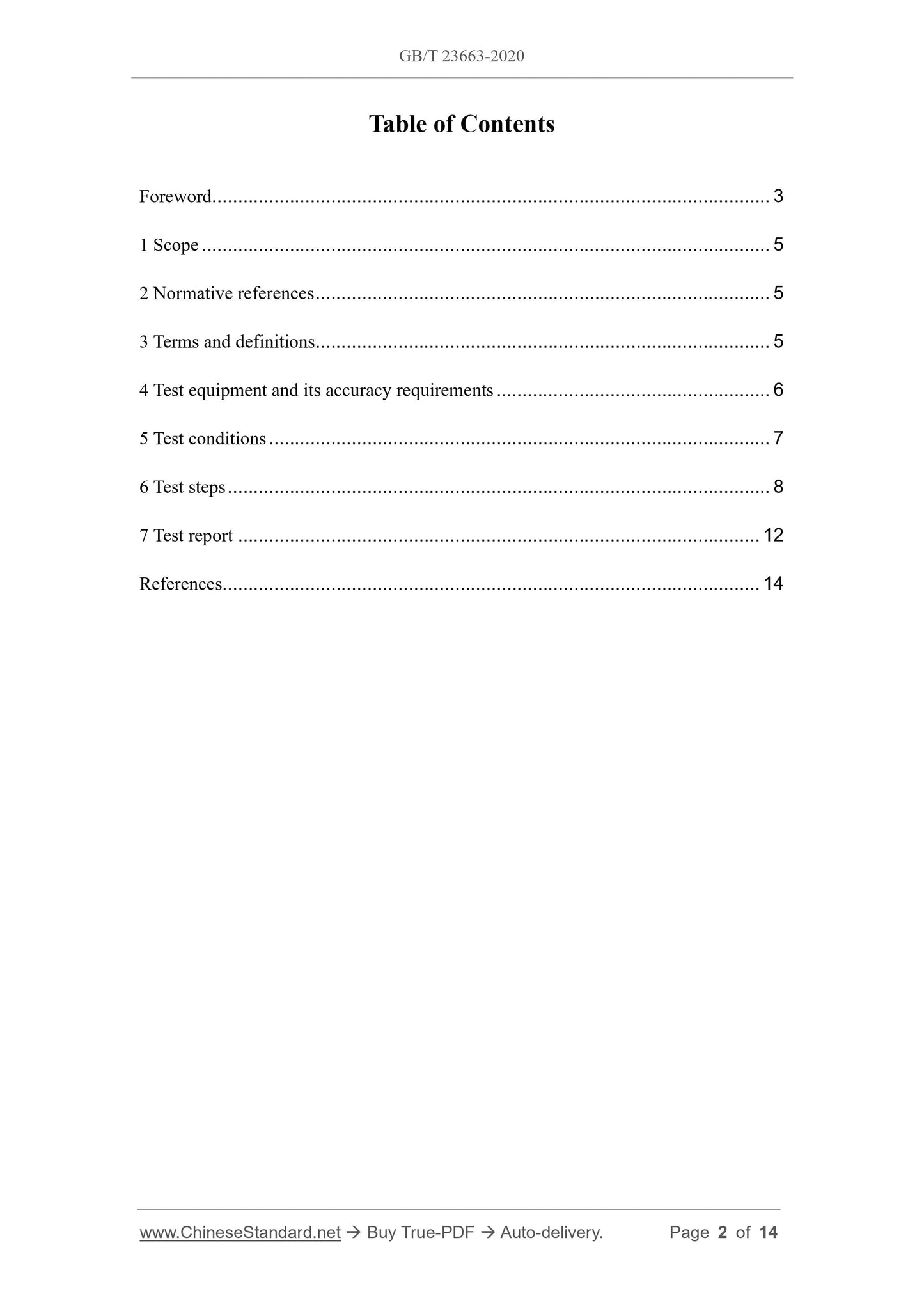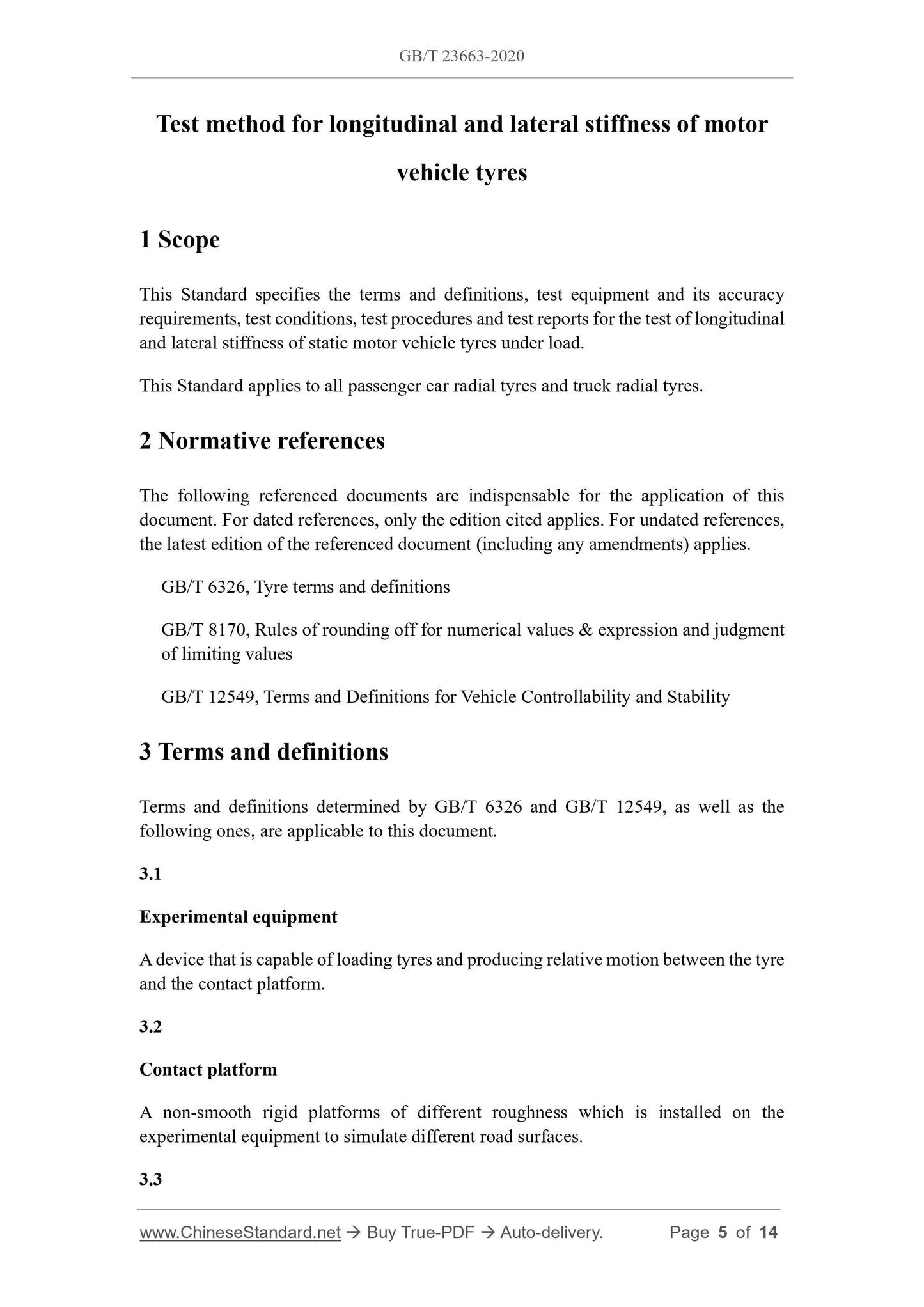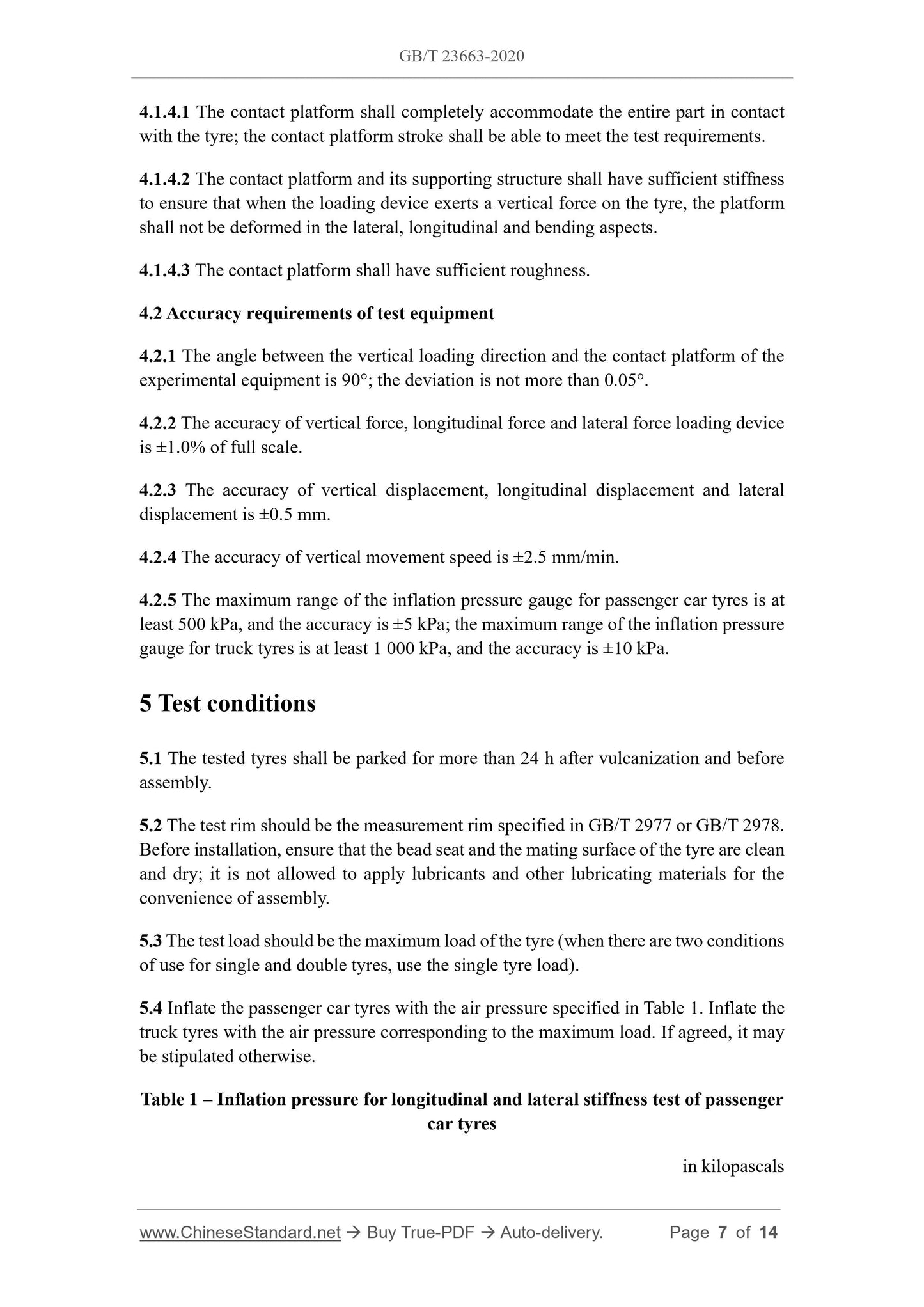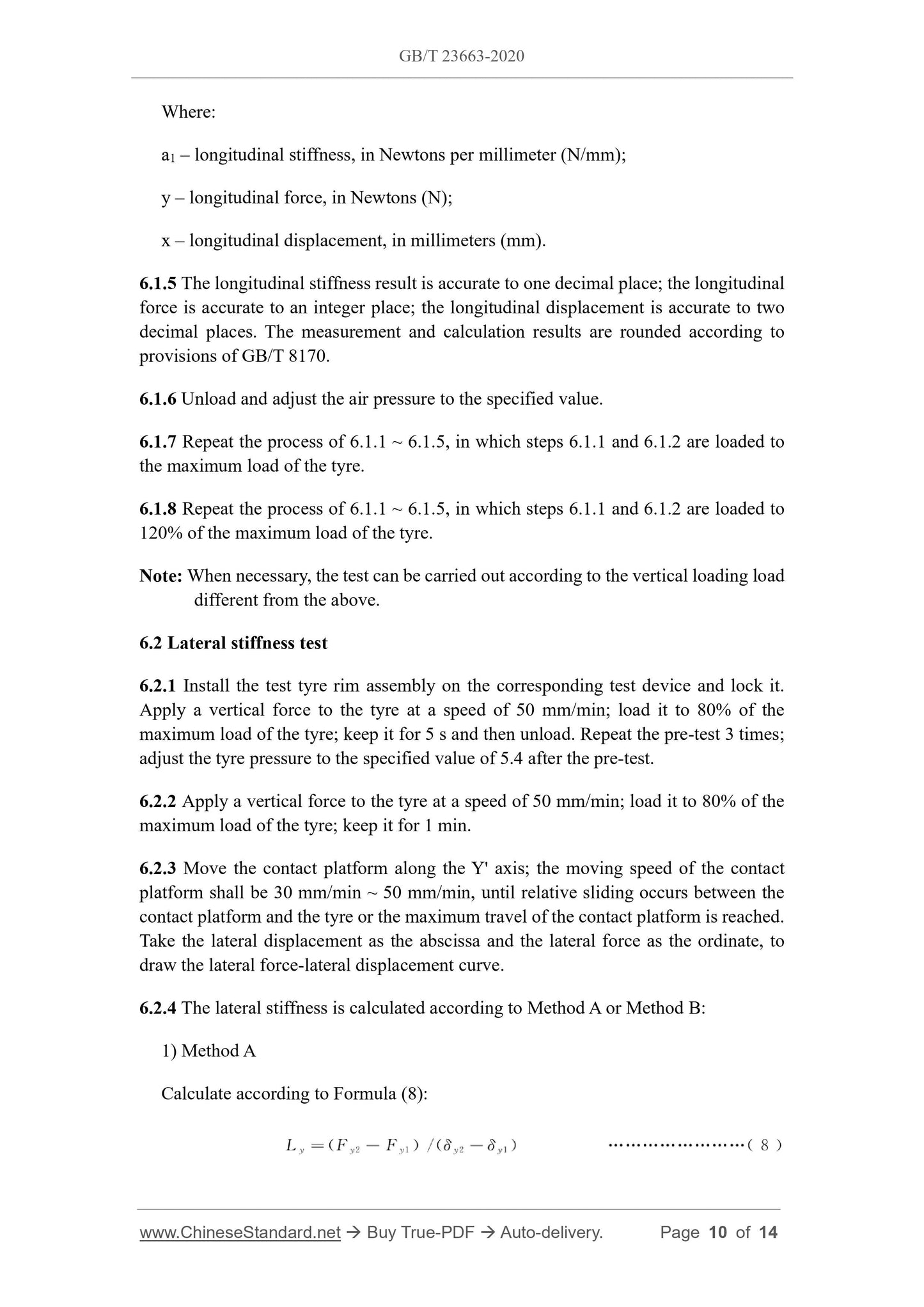1
/
of
5
PayPal, credit cards. Download editable-PDF & invoice In 1 second!
GB/T 23663-2020 English PDF (GBT23663-2020)
GB/T 23663-2020 English PDF (GBT23663-2020)
Regular price
$170.00 USD
Regular price
Sale price
$170.00 USD
Unit price
/
per
Shipping calculated at checkout.
Couldn't load pickup availability
Delivery: 3 seconds. Download true-PDF + Invoice.
Get QUOTATION in 1-minute: Click GB/T 23663-2020
Historical versions: GB/T 23663-2020
Preview True-PDF (Reload/Scroll if blank)
GB/T 23663-2020: Test method for longitudinal and lateral stiffness of motor vehicle tyres
GB/T 23663-2020
NATIONAL STANDARD OF THE
PEOPLE’S REPUBLIC OF CHINA
ICS 83.160.10
G 41
Replacing GB/T 23663-2009
Test method for longitudinal and lateral stiffness of motor
vehicle tyres
ISSUED ON: DECEMBER 14, 2020
IMPLEMENTED ON: NOVEMBER 01, 2021
Issued by: State Administration for Market Regulation;
Standardization Administration of the People’s Republic of China.
Table of Contents
Foreword ... 3
1 Scope ... 5
2 Normative references ... 5
3 Terms and definitions... 5
4 Test equipment and its accuracy requirements ... 6
5 Test conditions ... 7
6 Test steps ... 8
7 Test report ... 12
References ... 14
Test method for longitudinal and lateral stiffness of motor
vehicle tyres
1 Scope
This Standard specifies the terms and definitions, test equipment and its accuracy
requirements, test conditions, test procedures and test reports for the test of longitudinal
and lateral stiffness of static motor vehicle tyres under load.
This Standard applies to all passenger car radial tyres and truck radial tyres.
2 Normative references
The following referenced documents are indispensable for the application of this
document. For dated references, only the edition cited applies. For undated references,
the latest edition of the referenced document (including any amendments) applies.
GB/T 6326, Tyre terms and definitions
GB/T 8170, Rules of rounding off for numerical values and expression and judgment
of limiting values
GB/T 12549, Terms and Definitions for Vehicle Controllability and Stability
3 Terms and definitions
Terms and definitions determined by GB/T 6326 and GB/T 12549, as well as the
following ones, are applicable to this document.
3.1
Experimental equipment
A device that is capable of loading tyres and producing relative motion between the tyre
and the contact platform.
3.2
Contact platform
A non-smooth rigid platforms of different roughness which is installed on the
experimental equipment to simulate different road surfaces.
3.3
4.1.4.1 The contact platform shall completely accommodate the entire part in contact
with the tyre; the contact platform stroke shall be able to meet the test requirements.
4.1.4.2 The contact platform and its supporting structure shall have sufficient stiffness
to ensure that when the loading device exerts a vertical force on the tyre, the platform
shall not be deformed in the lateral, longitudinal and bending aspects.
4.1.4.3 The contact platform shall have sufficient roughness.
4.2 Accuracy requirements of test equipment
4.2.1 The angle between the vertical loading direction and the contact platform of the
experimental equipment is 90°; the deviation is not more than 0.05°.
4.2.2 The accuracy of vertical force, longitudinal force and lateral force loading device
is ±1.0% of full scale.
4.2.3 The accuracy of vertical displacement, longitudinal displacement and lateral
displacement is ±0.5 mm.
4.2.4 The accuracy of vertical movement speed is ±2.5 mm/min.
4.2.5 The maximum range of the inflation pressure gauge for passenger car tyres is at
least 500 kPa, and the accuracy is ±5 kPa; the maximum range of the inflation pressure
gauge for truck tyres is at least 1 000 kPa, and the accuracy is ±10 kPa.
5 Test conditions
5.1 The tested tyres shall be parked for more than 24 h after vulcanization and before
assembly.
5.2 The test rim should be the measurement rim specified in GB/T 2977 or GB/T 2978.
Before installation, ensure that the bead seat and the mating surface of the tyre are clean
and dry; it is not allowed to apply lubricants and other lubricating materials for the
convenience of assembly.
5.3 The test load should be the maximum load of the tyre (when there are two conditions
of use for single and double tyres, use the single tyre load).
5.4 Inflate the passenger car tyres with the air pressure specified in Table 1. Inflate the
truck tyres with the air pressure corresponding to the maximum load. If agreed, it may
be stipulated otherwise.
Table 1 – Inflation pressure for longitudinal and lateral stiffness test of passenger
car tyres
in kilopascals
Where:
a1 – longitudinal stiffness, in Newtons per millimeter (N/mm);
y – longitudinal force, in Newtons (N);
x – longitudinal displacement, in millimeters (mm).
6.1.5 The longitudinal stiffness result is accurate to one decimal place; the longitudinal
force is accurate to an integer place; the longitudinal displacement is accurate to two
decimal places. The measurement and calculation results are rounded according to
provisions of GB/T 8170.
6.1.6 Unload and adjust the air pressure to the specified value.
6.1.7 Repeat the process of 6.1.1 ~ 6.1.5, in which steps 6.1.1 and 6.1.2 are loaded to
the maximum load of the tyre.
6.1.8 Repeat the process of 6.1.1 ~ 6.1.5, in which steps 6.1.1 and 6.1.2 are loaded to
120% of the maximum load of the tyre.
Note: When necessary, the test can be carried out according to the vertical loading load
different from the above.
6.2 Lateral stiffness test
6.2.1 Install the test tyre rim assembly on the corresponding test device and lock it.
Apply a vertical force to the tyre at a speed of 50 mm/min; load it to 80% of the
maximum load of the tyre; keep it for 5 s and then unload. Repeat the pre-test 3 times;
adjust the tyre pressure to the specified value of 5.4 after the pre-test.
6.2.2 Apply a vertical force to the tyre at a speed of 50 mm/min; load it to 80% of the
maximum load of the tyre; keep it for 1 min.
6.2.3 Move the contact platform along the Y' axis; the moving speed of the contact
platform shall be 30 mm/min ~ 50 mm/min, until relative sliding occurs between the
contact platform and the tyre or the maximum travel of the contact platform is reached.
Take the lateral displacement as the abscissa and the lateral force as the ordinate, to
draw the lateral force-lateral displacement curve.
6.2.4 The lateral stiffness is calculated according to Method A or Method B:
1) Method A
Calculate according to Formula (8):
Get QUOTATION in 1-minute: Click GB/T 23663-2020
Historical versions: GB/T 23663-2020
Preview True-PDF (Reload/Scroll if blank)
GB/T 23663-2020: Test method for longitudinal and lateral stiffness of motor vehicle tyres
GB/T 23663-2020
NATIONAL STANDARD OF THE
PEOPLE’S REPUBLIC OF CHINA
ICS 83.160.10
G 41
Replacing GB/T 23663-2009
Test method for longitudinal and lateral stiffness of motor
vehicle tyres
ISSUED ON: DECEMBER 14, 2020
IMPLEMENTED ON: NOVEMBER 01, 2021
Issued by: State Administration for Market Regulation;
Standardization Administration of the People’s Republic of China.
Table of Contents
Foreword ... 3
1 Scope ... 5
2 Normative references ... 5
3 Terms and definitions... 5
4 Test equipment and its accuracy requirements ... 6
5 Test conditions ... 7
6 Test steps ... 8
7 Test report ... 12
References ... 14
Test method for longitudinal and lateral stiffness of motor
vehicle tyres
1 Scope
This Standard specifies the terms and definitions, test equipment and its accuracy
requirements, test conditions, test procedures and test reports for the test of longitudinal
and lateral stiffness of static motor vehicle tyres under load.
This Standard applies to all passenger car radial tyres and truck radial tyres.
2 Normative references
The following referenced documents are indispensable for the application of this
document. For dated references, only the edition cited applies. For undated references,
the latest edition of the referenced document (including any amendments) applies.
GB/T 6326, Tyre terms and definitions
GB/T 8170, Rules of rounding off for numerical values and expression and judgment
of limiting values
GB/T 12549, Terms and Definitions for Vehicle Controllability and Stability
3 Terms and definitions
Terms and definitions determined by GB/T 6326 and GB/T 12549, as well as the
following ones, are applicable to this document.
3.1
Experimental equipment
A device that is capable of loading tyres and producing relative motion between the tyre
and the contact platform.
3.2
Contact platform
A non-smooth rigid platforms of different roughness which is installed on the
experimental equipment to simulate different road surfaces.
3.3
4.1.4.1 The contact platform shall completely accommodate the entire part in contact
with the tyre; the contact platform stroke shall be able to meet the test requirements.
4.1.4.2 The contact platform and its supporting structure shall have sufficient stiffness
to ensure that when the loading device exerts a vertical force on the tyre, the platform
shall not be deformed in the lateral, longitudinal and bending aspects.
4.1.4.3 The contact platform shall have sufficient roughness.
4.2 Accuracy requirements of test equipment
4.2.1 The angle between the vertical loading direction and the contact platform of the
experimental equipment is 90°; the deviation is not more than 0.05°.
4.2.2 The accuracy of vertical force, longitudinal force and lateral force loading device
is ±1.0% of full scale.
4.2.3 The accuracy of vertical displacement, longitudinal displacement and lateral
displacement is ±0.5 mm.
4.2.4 The accuracy of vertical movement speed is ±2.5 mm/min.
4.2.5 The maximum range of the inflation pressure gauge for passenger car tyres is at
least 500 kPa, and the accuracy is ±5 kPa; the maximum range of the inflation pressure
gauge for truck tyres is at least 1 000 kPa, and the accuracy is ±10 kPa.
5 Test conditions
5.1 The tested tyres shall be parked for more than 24 h after vulcanization and before
assembly.
5.2 The test rim should be the measurement rim specified in GB/T 2977 or GB/T 2978.
Before installation, ensure that the bead seat and the mating surface of the tyre are clean
and dry; it is not allowed to apply lubricants and other lubricating materials for the
convenience of assembly.
5.3 The test load should be the maximum load of the tyre (when there are two conditions
of use for single and double tyres, use the single tyre load).
5.4 Inflate the passenger car tyres with the air pressure specified in Table 1. Inflate the
truck tyres with the air pressure corresponding to the maximum load. If agreed, it may
be stipulated otherwise.
Table 1 – Inflation pressure for longitudinal and lateral stiffness test of passenger
car tyres
in kilopascals
Where:
a1 – longitudinal stiffness, in Newtons per millimeter (N/mm);
y – longitudinal force, in Newtons (N);
x – longitudinal displacement, in millimeters (mm).
6.1.5 The longitudinal stiffness result is accurate to one decimal place; the longitudinal
force is accurate to an integer place; the longitudinal displacement is accurate to two
decimal places. The measurement and calculation results are rounded according to
provisions of GB/T 8170.
6.1.6 Unload and adjust the air pressure to the specified value.
6.1.7 Repeat the process of 6.1.1 ~ 6.1.5, in which steps 6.1.1 and 6.1.2 are loaded to
the maximum load of the tyre.
6.1.8 Repeat the process of 6.1.1 ~ 6.1.5, in which steps 6.1.1 and 6.1.2 are loaded to
120% of the maximum load of the tyre.
Note: When necessary, the test can be carried out according to the vertical loading load
different from the above.
6.2 Lateral stiffness test
6.2.1 Install the test tyre rim assembly on the corresponding test device and lock it.
Apply a vertical force to the tyre at a speed of 50 mm/min; load it to 80% of the
maximum load of the tyre; keep it for 5 s and then unload. Repeat the pre-test 3 times;
adjust the tyre pressure to the specified value of 5.4 after the pre-test.
6.2.2 Apply a vertical force to the tyre at a speed of 50 mm/min; load it to 80% of the
maximum load of the tyre; keep it for 1 min.
6.2.3 Move the contact platform along the Y' axis; the moving speed of the contact
platform shall be 30 mm/min ~ 50 mm/min, until relative sliding occurs between the
contact platform and the tyre or the maximum travel of the contact platform is reached.
Take the lateral displacement as the abscissa and the lateral force as the ordinate, to
draw the lateral force-lateral displacement curve.
6.2.4 The lateral stiffness is calculated according to Method A or Method B:
1) Method A
Calculate according to Formula (8):
Share
